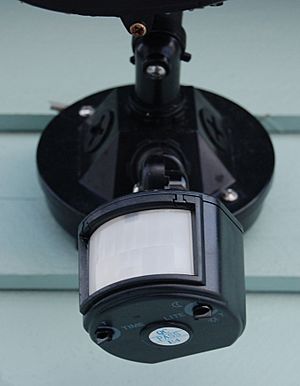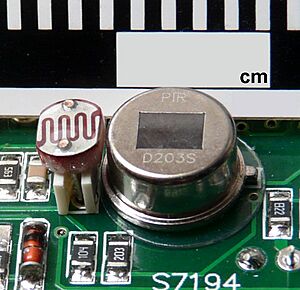Motion detector facts for kids
A motion detector is an electronic device that uses a sensor to notice movement nearby. These devices are often part of bigger systems. They can automatically do a task or warn someone about movement in an area. Motion detectors are very important for security, automatic lights, smart homes, saving energy, and many other helpful systems.
Contents
How Motion Detectors Work
Motion detectors can be active or passive. An active detector sends out a signal, like light, microwaves, or sound. Then it waits for that signal to bounce back. A passive detector only listens for signals coming from moving objects, like heat or reflections.
These devices look for changes in light, microwave, or sound fields around them. When something moves, it changes these fields. The detector's electronics then figure out that there's movement. Many common motion detectors can spot movement up to about 4.5 meters (15 feet) away. More advanced systems can be more sensitive or cover much larger areas. Some special systems, called tomographic detectors, can even sense movement through walls!
Motion detectors are used in many places. You might see them opening automatic doors in stores or public buildings. They also turn on smart lighting in places like hallways or staircases. This saves energy because the lights only stay on when someone is there. Motion detectors are also a key part of burglar alarms. They can alert a homeowner or security company if an intruder is detected. They might even start a security camera recording.
Types of Motion Sensors
Different kinds of motion detectors use various technologies to sense movement.
Passive Infrared (PIR) Sensors
Passive infrared (PIR) sensors are sensitive to heat. They can detect the heat that people's skin gives off. This heat is a type of infrared light. The sensor itself does not send out any energy, which is why it's called "passive." This is different from an electric eye, which uses a beam of light that gets broken when someone walks through it. PIR sensors are great for finding people or animals by sensing their body heat.
Microwave Sensors
Microwave sensors work like a radar speed gun. They send out a steady stream of microwave energy. When an object moves toward or away from the sensor, it changes the microwaves that bounce back. This change tells the sensor that something is moving.
Ultrasonic Sensors
An ultrasonic transducer sends out ultrasonic waves. These are sound waves that are too high-pitched for humans to hear. The sensor then listens for the sound waves that bounce back from objects nearby. Just like with microwave sensors, changes in these bouncing sound waves tell the sensor about movement. One thing to know about ultrasonic sensors is that sound waves can bounce around corners. This means they might detect motion in areas you don't want them to.
Tomographic Motion Detectors
These systems detect changes in radio waves as they travel between different points in a network. They can cover very large areas because their radio waves can go through walls and other obstacles. Tomographic systems can use special equipment or even other wireless devices that have been updated with special software.
Video Camera Software
Many affordable digital cameras can record video. This means you can use software with these cameras to detect motion. The software looks for changes in the camera's view. This is a good option if you want to record video when motion is detected. You only need the camera and a computer. This method is also "passive" because it usually uses normal light. However, it can also use near-infrared light to detect motion in the dark, using light that human eyes can't see.
Gesture Detectors
Gesture detectors use light sensors and infrared lights. They work with digital screens to understand hand movements and gestures. They use special computer programs called machine learning algorithms to figure out what your hands are doing.
Combining Technologies
Many modern motion detectors use a mix of different technologies. For example, a common type combines a PIR sensor and a microwave sensor in one unit. For the detector to "trip" (detect motion), both sensors must sense movement at the same time. This helps stop false alarms. For instance, a sudden change in heat might trigger the PIR sensor but not the microwave sensor. Or, moving tree branches might trigger the microwave but not the PIR. If both sensors need to be triggered, it's less likely to be a false alarm.
Often, PIR technology is paired with another type because PIR uses less energy than microwave detection. So, a sensor might be set up so that the PIR sensor turns on the microwave sensor first. If the microwave sensor also detects an intruder, then the alarm goes off.
See also
 In Spanish: Detector de movimiento para niños
In Spanish: Detector de movimiento para niños
- Twilight switch
- Heat detector
- Motion capture
- Motion controller for video game consoles
- Pickup (music technology)
- Proximity sensor
- Remote camera
- Smoke detector



